Abstract
The concepts of the world-image, picture of the world and the concept of the world are analyzed. It is shown the importance of personalizing world-image and expanding concepts of other cultures and countries for positive socialization in the transitive multicultural society. Materials analyzing the role of language and linguistic identity in transformation the picture of the world and forming the intention for the acquaintance with other cultures are analyzed. The results of an empirical study about the influence of the experience of interaction with another culture are presented. The participants were the students of two Moscow universities - MSRU and MSIIR. The aim of the study was the role of world-image in attitude to foreign cultures and structuring of the social and personal identity. It is shown that knowledge of the foreign languages, other countries and other cultures alters the attitude to one's own and another's culture and to one's own and another's peoples. Experience (real and virtual) of interaction with another culture is connected with the transformation of the world-image. This experience also leads to the restructuring of social identity, which includes not only the native country, but the all mankind, the world as a whole. The tendency to personalizing identity, which characterizes respondents, affects the content of identity, but not the content of the picture of the world and the attitude to other cultures. The presence of experience of interaction with another socio-cultural environment is an important fact that determines the content and boundaries of the world picture.
Keywords: World-imagesociallinguistic and personal identityexperience of interaction with another culture
Introduction
World image
The world image can be considered as the most general concept, the structure of which includes the picture of the world and the concept of the world (Leontev, 1975). The content of ideas about the world is constantly transformed, as judgments about oneself, about space and time change. The combination of the image of the world and the picture of the world is possible both as a link between the conscious and unconscious parts of the picture of the world, and as a connection between images and judgments about oneself and the world. So in the picture of the world there are not only generalized schemes of reality, systems that reflect the interconnection of different worlds, groups, people, but also personalized strategies of behavior.
The question of the relationship between the objective and subjective, the individual in the picture of the world is extremely important, especially in the situation of variability and multiplicity of parameters that determine its content. Relationships, experiences help to establish the relationship between the objective and subjective, personal parameters of the world picture. In a situation where there is a constant change and construction of a picture of the world, the category of experience can be viewed not only as an emotional reaction, but also as a specific mechanism that unites personal and public, personal and individual identity in the process of actively designing the world picture.
Social transitivity actualizes the question of the correlation of different aspects of the picture of the world. Even a superficial analysis makes it possible to see some of the cardinal changes that are most characteristic of today. A new era, in particular, is characterized by traits such as globalization, serious ethnic and religious conflicts, the perceptions of human activity in the construction of the world, the pronounced state of uncertainty in the understanding of the goals and the directions of society development (Martsinkovskaya, 2015a). The volatility of the world and its picture in the minds of people of different mentality, education and social affiliation changes the idea of interpersonal and intergroup relations, complicating or, on the contrary, simplifying contacts with people of foreign culture. New means of transportation and communication also affect the changes in the world picture.
Increasing the migration leads to the need for interpersonal interaction among people belonging to different cultures, so it becomes extremely important to analyze the causes of people’s disadaptation to new living conditions, disregard or passive rejection of that culture, those traditions that are significant for a new social environment (Аndreeva & Dontsova, 2002). The interaction of people with different mentality, different languages and different values leads to the necessity of comprehending on both the everyday and the scientific level the relativity of our ideas about truth, about what is good and what is bad. It is important to evaluate the same position from different points of view, in different approaches and by different people.
Linguistic identity
The concept of “need for language” is relatively new in sociolinguistics, and even more so – in the psychology of personality. In a transitive society, acculturation, acceptance and appropriation of culture are one of the important factors determining the success of socialization in new conditions. The native culture and the language are “absorbed with the mother’s milk” from an early age and remain unchanged even when the way of life, world outlook, political and economic aspects of the social situation change. This constancy emphasizes culture as a factor that helps to “restore the connection of times”, it is culture that is emotionally perceived as a whole, as part of social, ethnic and personal identity, that gives rootedness and stability, allowing to find support points in changing reality and to restore lost integrity of perception of world and oneself (Martsinkovskaya & Siyuchenko, 2014).
The role of language in the process of the formation of a sociocultural identity is ambiguous (Chomsky, 1999; Fodor, 1975). Apparently, we can talk about the interconnection of language, culture and identity. Language has a significant impact not only on ethnic, sociocultural, but also on group identity. In fact, the concept of speech production and perception was developed by N.I. Zhinkin (1964). He proceeded from the fact that the information communication of people is one of the leading forming their self-consciousness. Analyzing the processes of formation and interaction of language, speech and intelligence, Zhinkin came to the conclusion that they should be considered as three different codes of a unified system aimed at creating and transmitting information. Introduced by him the concept of universal subject code helps to understand not only the relationship between different types of language, thinking and speech, but also the transfer of cross cultural information in the process of interaction of communicators speaking another language.
Studies of the interrelation between thinking and speech are also considered from the point of view of what is the leading parameter here. The concept of Sapir-Whorf’s linguistic relativity proceeds from the positions of linguistic determinism, since it proves that the structure of language determines the thinking and way of knowing reality. It is assumed that people, who speak different languages, perceive the world differently and think differently. From the linguistic characteristics of European languages are derived not only the features of European culture, but also the most important achievements of European science.
Problem Statement
The worth of the concept “world image” in the development of person and his ideas about his place in the surrounding space cannot be overestimated. At the same time, the question about transformations in the modern content of the world picture, as well as about the constants in the content and structure of this concept from the point of view of psychology, needs to be operationalized and filled with concrete data. To do this, it is necessary to analyze possible options for structuring the concept of the world image, as well as the specifics of the current situation, which should be reflected in its content.
No less important is the study of the role of the world picture in the identity’s formation in the modern multicultural world. From this point of view, it is important to study the breadth of worldviews and knowledges about different cultures and to analyze the relationship of these parameters to the integrity of sociocultural identity and tolerance to a multicultural environment.
Research Questions
It seems that the expansion of the world image, knowledge of other cultures, other languages and norms, can lead to an increase in positive attitudes towards other peoples and help to structure the identity.
Purpose of the Study
These assumptions were checked in the course of the empirical study about the influence of the experience of interaction with another culture on the content of world-image, attitude to foreign cultures and structure of the social and personal identity.
Research Methods
The questionnaire “Attitude to one's own and other people” (Martsinkovskaya, 2017);
The questionnaire “Structure of social identity” (Martsinkovskaya, 2015);
The questionnaire “Personal identity” (Martsinkovskaya, 2015).
The study was conducted in 2017-2018. All the participants gave their consent to participate in the study.
Findings
An analysis of the answers of two groups of respondents with or without experience of interaction with another, a "new" social environment, shows that the overwhelming majority of MSIIR’s students have such experience, while most students of MSRU do not have such experience, mainly because they don’t know foreign languages. Therefore, MSRU students characterize modern culture mainly negatively, describing it as a consumption culture, where the external form prevails over the inner content. On the contrary, the majority of respondents who have experience of interaction with a different cultural environment, notes the development of modern culture, saying that now there are more opportunities to visit new places, including using the Internet. These respondents also emphasize that the culture is developing in a new direction, related to the progress in the field of information technology and the emergence of new forms of interaction between people. At the same time MSIIR’s students in their answers constantly stressed that it is concerns not only Russian, but the world culture in general. An important point is the fact that students who have a poor knowledge of a foreign language and who have not traveled to other countries, speaking about a world without borders, have in mind mainly the absence of territorial boundaries. MSIIR’s students also stressed the possibility of free communication and interaction with people from different cultural environments.
Quantitative analysis of the obtained data showed that students of MSRU pointed out more “foreign” ethnic groups than “their own”, while for MSIIR students their number is approximately the same (Fig. 1). The number of “own” among the students that study a language, is increased with including “European” ethnic groups in addition to ethnic groups residing in Russia or neighboring countries. This is probably due to the fact that students, learning the language of another country and getting acquainted with its culture, find much in common with their own.
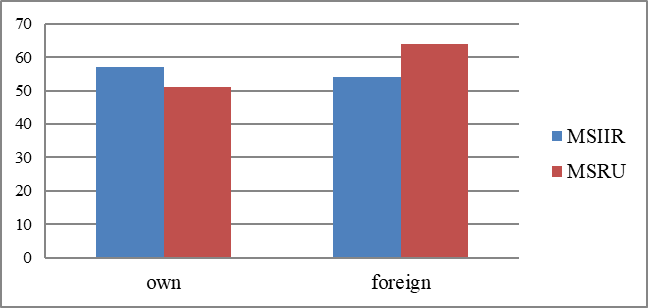
The analysis of the data also showed that the respondents presented the same number of characteristics from both own ethnic groups and foreign ethnic groups. Using a qualitative analysis, the emotional attitude of respondents towards the other cultures was revealed. Figure
It should be noted that among respondents' answers there is no positive characteristic of “foreign” ethnic groups and no negative description of “their own”. Probably, this is due to the fact that the respondents' opinions about “their own” and “foreign” cultures are formed mainly on the news material on the Internet, in television programs where the culture of their people, unlike the culture of another’s, is often shown positively.
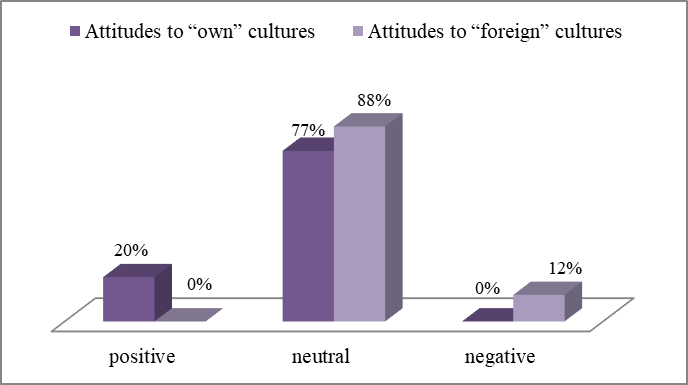
Analysis of the descriptions of MSIIR students (Fig. 3) showed that attitude of the respondents to their own and to foreign cultures is more neutral as much as attitude of the respondents who did not learn foreign languages. However, there are more neutral characteristics to other ethnic groups than to their own, and positive ones, on the contrary, are more to “their own” than to “foreign”. It should also be noted that the number of negative descriptions is approximately the same - 10% in relation to “their own” and 8% to “foreign”.
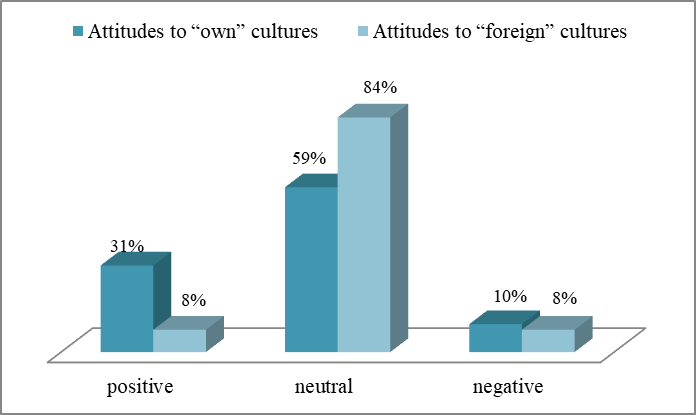
In comparing the descriptions of “their” and “foreign” ethnic groups (Fig. 4), it is noteworthy that the students of MSIIR, unlike the students of MSRU, see negative qualities in their native cultures, and in others they see also positive. Among their negative qualities there are found the unflagging, rude, pretentious, and among the positive ones there are affable, modest, tactful, etc.
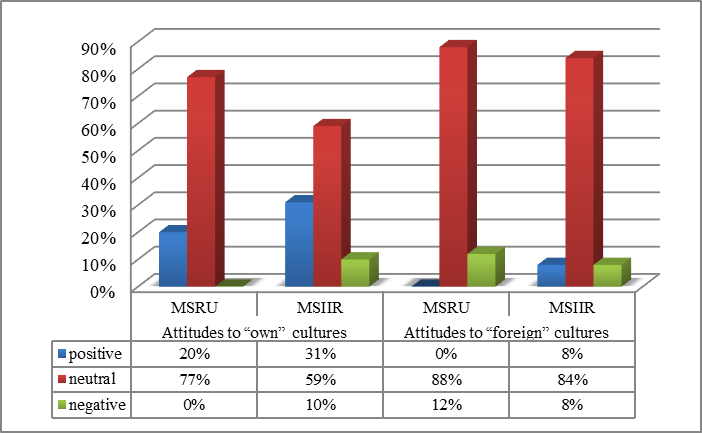
Thus, it is shown that in learning a foreign language and getting acquainted with other cultures, the image of the world changes and a more varied attitude to own and foreign culture is formed.
Comparative analysis of the structure of social identity showed that the students of both groups have the family in the first place (Table
It can be assumed that the leading role of the family is due to the fact that it plays for all respondents the role of emotional protection and support in a complex multicultural world. Identification with people of one generation, as well as gender identity, also seem to help to find common positions in a multicultural world. Apparently, respondents proceeded from the fact that people of the same age and gender group are easier to understand each other, just like people of the same family.
At the same time, it is clearly visible that for MSIIR students the identity group is the whole of humanity, while for MSRU students there are only people living in the same country with them. In this, apparently, it affects a more general picture of the world of young people who can communicate with people of other cultures. This communication not only increases the positive perception of other peoples, but also expands the picture of the world in which different cultures and different countries are harmoniously united. These data are confirmed by the results obtained in the study of the attitude towards "own" and "foreign" peoples.
Analysis of self-descriptions of students of both groups showed dominance of subjective characteristics reflecting the role and personality qualities of the respondents (Fig. 5). It should be noted that the students of MSRU often wrote such characteristics as “a Russian”, while the students of MSIIR had “a citizen of the country” or “a citizen of the world”. The MSRU students also had more frequent self-descriptions, including characteristics of appearance and profession (blonde with green eyes, tall, thin future accountant or economist, manager). The MSIIR students often pointed out mentions of personal characteristics that often have ambivalent properties (cheerful, a ringleader, active, insecure, embodied disbalance, different).
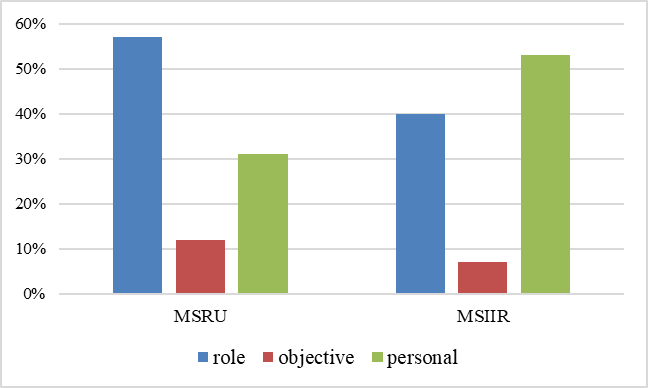
It is also necessary to note the appearance of new categories in the group of subjective characteristics in the MSIIR students. Such as, for example, “plants, natural phenomena” (flower, tree, cherry, nature, ice, star, light, wind), “animals” (dreamy bird, etc.), “philosophical and mythological categories” (statement, search, aspiration, rebirth, loss, movement, deed, words, infinity, fresh idea, part of history, life, goddess, world, person, judge, etc.), “ideal categories” (soul, spirituality, good). In addition, there are also definitions related to the new social roles: “Maecenas”, “founder of the foundation for helping hungry children in Africa, the foundation for the future of the Earth", etc. In the students of MSRU, self-descriptions related to the future family life and career, have dominant role.
Analysis of the obtained data using correlation analysis (Pearson correlation coefficients) revealed the following relationships. It was found a direct correlation between the attitude towards “own” and “foreign” peoples and the rating of the group of country, nation and humanity (R = 0, 787).
In turn, the expression of personal characteristics is associated with a high rating of such groups in the structure of social identity as a profession (R = 0.442) and hobbies (R = 0.819).
Conclusion
The existence of experience of interaction with another socio-cultural environment is an important condition that determines the content and boundaries of the world-image.
Knowledge of other people, other languages and other cultures expands the content of sociocultural identity, facilitating the transformation of world image. At the same time, the inclusion of a new culture in the picture of the world changes the emotional attitude towards one's own and other nations.
The enlargement of the world image is connected with the changes in the structure of social identity, which includes new identification groups that are associated not only with the country, but with humanity as a whole.
Knowledge of different cultures and different languages determines the content of the world picture. Lack of experience of interaction with a different social environment is associated with a decrease in the ability to consider the native culture in more detailed and multifaceted ways.
The tendency to personify identity, which characterizes all respondents, regardless of experience of interaction with another socio-cultural environment, affects the content of identity, but not the content of the world image and the attitude to other nations and cultures.
References
- Аndreeva, G.M. & Dontsova, A.I. (Eds.). (2002). Social psychology in the modern world. Moscow: Aspect Press.
- Chomsky, A. N. (1999). Language and thought. Moscow: BGK named after Ja.N.I. Baudouin de Courtenay.
- Fodor, J.A. (1975). The language of thought. Cambridge: Harvard University Press.
- Leontev, A.N. (1975). Activity. Consciousness. Personality. Moscow: Politizdat.
- Martsinkovskaya, T.D. (2015a). Modern psychology - challenges of transitivity. Psikhologicheskie Issledovaniya, 8(42), 1. Retrieved from http://psystudy.ru/index.php/num/2015v8n42/1168-martsinkovskaya42.html
- Martsinkovskaya, T.D. (Eds.). (2015). Identity and socialization in the modern world. Moscow: MPGU Press.
- Martsinkovskaya, T.D. (Eds.). (2017). Identity in everyday and transitive world. Moscow: MPGU Press.
- Martsinkovskaya, T.D. & Siyuchenko, A.S. (2014). Identity as a factor of socialization in a multicultural environment. Voprosy psichologii, 6, 3-14.
- Zhinkin, N.I. (1964). Code transitions in internal speech. Voprosy yasykoznaniya, 6, 26-38.
Copyright information

This work is licensed under a Creative Commons Attribution-NonCommercial-NoDerivatives 4.0 International License.
About this article
Publication Date
23 November 2018
Article Doi
eBook ISBN
978-1-80296-048-8
Publisher
Future Academy
Volume
49
Print ISBN (optional)
-
Edition Number
1st Edition
Pages
1-840
Subjects
Educational psychology, child psychology, developmental psychology, cognitive psychology
Cite this article as:
Martsinkovskaya, T., Orestova, V., Gavrichenko, O., Yurchenko, N., & Dubovskaya, E. (2018). World Image As A Factor Of The Identity’s Formation In Multicultural Space. In S. Malykh, & E. Nikulchev (Eds.), Psychology and Education - ICPE 2018, vol 49. European Proceedings of Social and Behavioural Sciences (pp. 416-424). Future Academy. https://doi.org/10.15405/epsbs.2018.11.02.45

